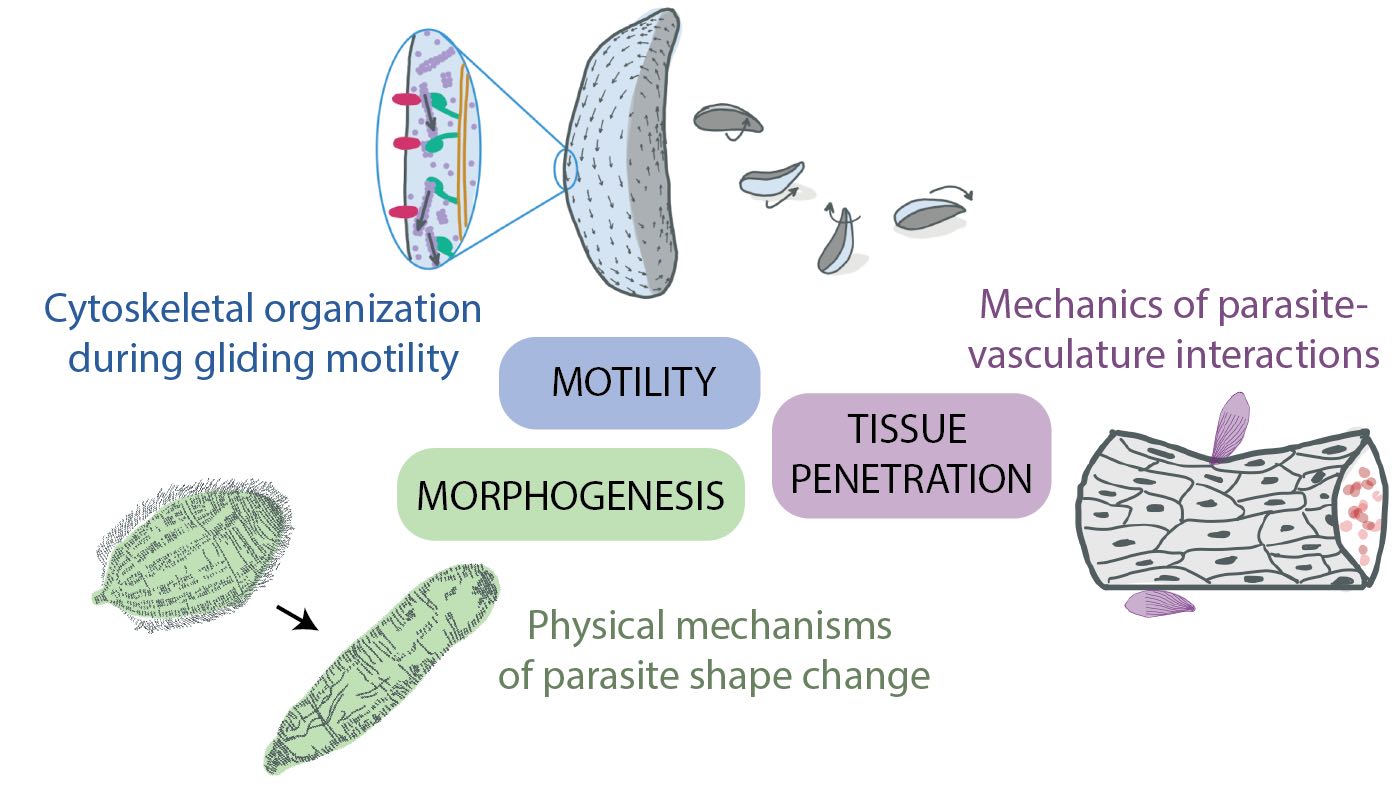Christina Hueschen
Research
The living world is weird and wonderful. The millions of species living on Earth showcase a mind-boggling diversity of cells and organisms, and much of this richness remains unexplored by science. Consider, for example, the incredible morphogenesis and mechanics of parasitic organisms. Schistosoma’s shape-shifting life cycle includes morphing between 200 µm cilia-covered swimmers and cm-long worms, while gliding unicellular Apicomplexa rocket over host cells thirty times faster than the lumbering human immune cells that chase them. What biophysical principles underlie these striking mechanical processes? How do parasites couple familiar eukaryotic building blocks for force-generation (actomyosin, muscle fibers) to their unique geometric forms to morph between life stages, or to move within and between hosts? Answering these questions informs both our physical understanding of the living world and our ability to outsmart the eukaryotic parasites that claim half a million human lives each year, most of them children.
The goal of the Hueschen Lab is to help understand the physical biology of parasites. We study how parasitic cells and animals move, penetrate through tissue, and change shape. We use microscopy, experimental approaches from cell and parasite biology, and physical thinking. Current topics of interest include the dynamics and patterning of cytoskeletal proteins inside parasitic cells like Toxoplasma and Plasmodium (malaria parasite), mechanisms of cell gliding motility, the mechanics of blood vessel penetration by parasites, and the mechanics of morphogenesis (shape change) in parasitic worms.

Select Publications
- Hueschen, C.L., Segev Zarko, L., Chen, J.H., LeGros, M.A., Larabell, C.A., Boothroyd, J.C., Phillips, R., and A.R. Dunn. Emergent actin flows explain diverse parasite gliding modes. Nature Physics. 2024
- Hueschen, C. and R. Phillips. The Restless Cell: Continuum Theories of Living Matter. [Book] Princeton University Press. August 2024.
- Hueschen, C.L., Dunn, A.R., and R. Phillips. Wildebeest herds on rolling hills: flocking on arbitrary curved surfaces. Physical Review E. 2023.
- Hueschen, C.L., Galstyan, V., Amouzgar, M., Phillips, R., and S. Dumont. Microtubule end-clustering maintains a steady-state spindle shape. Current Biology. 2019. PMID: 30744975.
- Gilder, A.L., Chapin, H.C., Padovano, V., Hueschen, C.L., Rajendran, V., and M.J. Caplan. Newly synthesized polycystin‐1 takes different trafficking pathways to the apical and ciliary membranes. Traffic. 2018. PMID: 30125442.
- Hueschen, C.L., Kenny, S.J., Xu, K., and S. Dumont. NuMA recruits dynein activity to microtubule minus-ends at mitosis. eLife. 2017. PMID: 29185983. [link]
- Guild J., Ginzberg M.B., Hueschen C.L., Mitchison T.J., and S. Dumont. Increased lateral microtubule contact at the cell cortex is sufficient to drive mammalian spindle elongation. Mol Biol Cell. 2017. PMID: 28468979. [link]
- Elting, M.W.*, Hueschen, C.L.*, Udy, D.B., and S. Dumont. Force on spindle microtubule minus-ends moves chromosomes. J of Cell Biol. 2014. PMID: 25023517. *denotes equal contribution
Biography
Christina Hueschen received her Ph.D. from the University of California, San Francisco (UCSF), where she worked with Sophie Dumont on cytoskeletal organization and mechanics and fell in love with physical biology. During her postdoctoral research in the group of Alex Dunn at Stanford University, she studied the gliding motility of unicellular parasites. Christina is a co-author of the book The Restless Cell: Continuum Theories of Living Matter, the result of a joy-filled adventure into the world of active matter with Rob Phillips. She joined the UCSD faculty in 2024.

